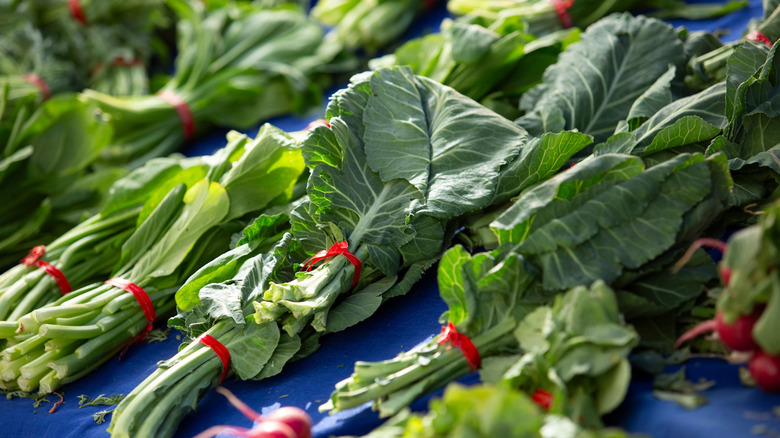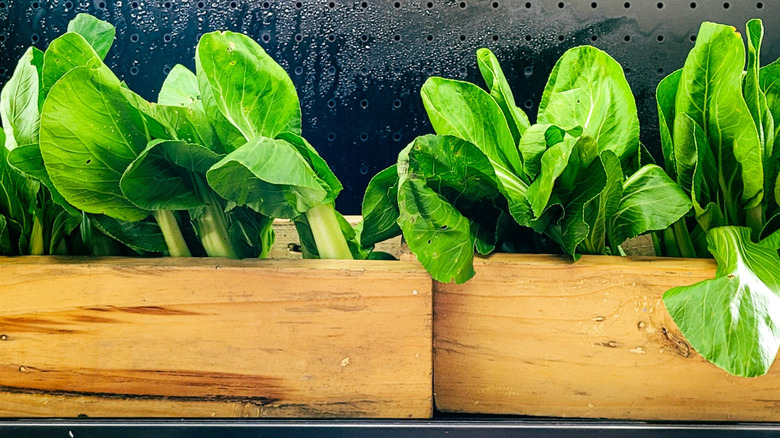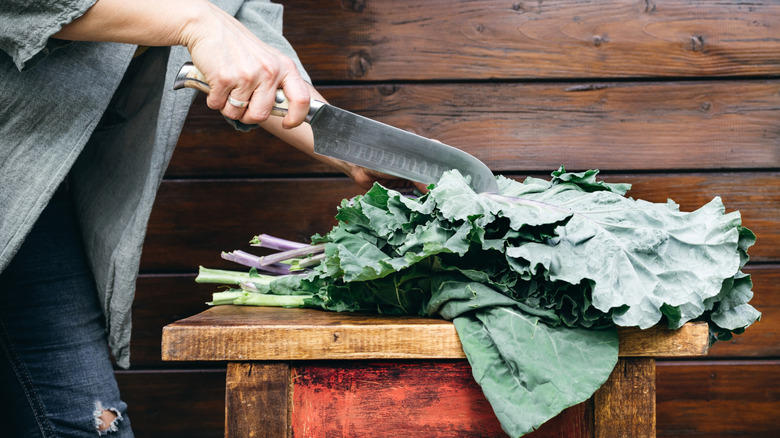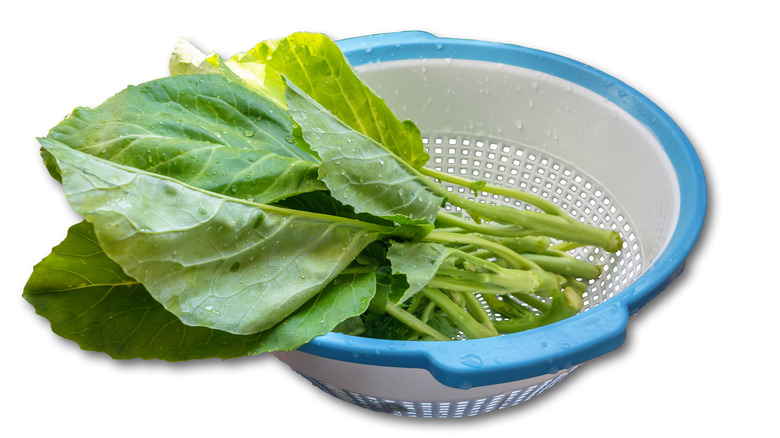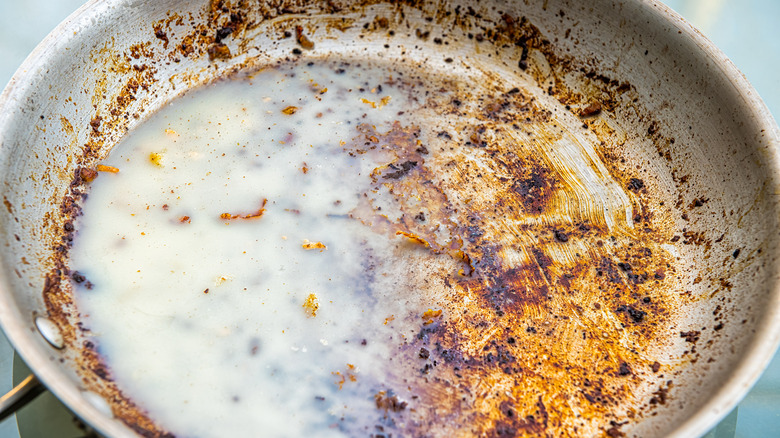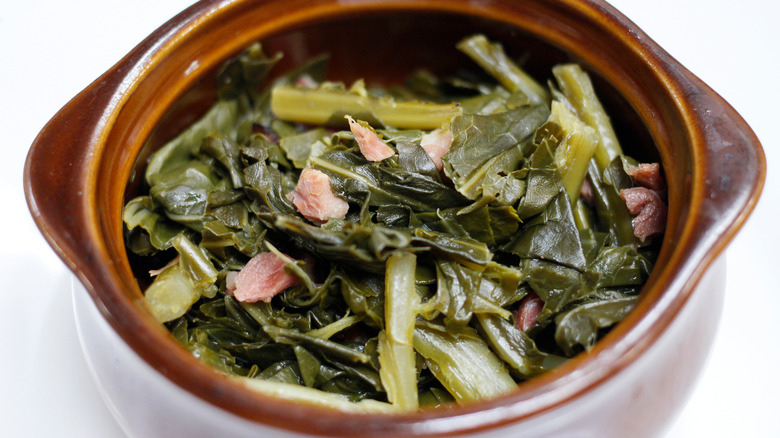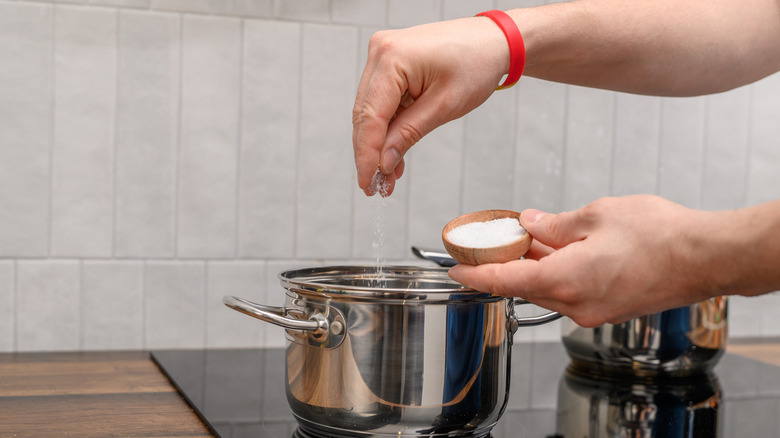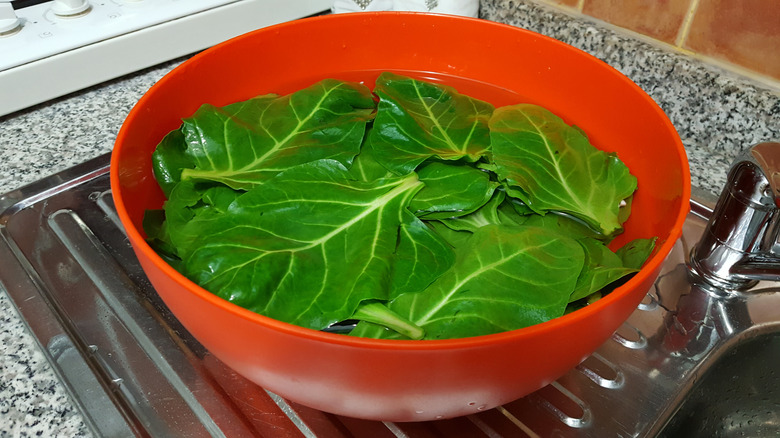Mistakes Everyone Makes With Collard Greens
We may receive a commission on purchases made from links.
Collard greens are a Southern staple. They're often served alongside comfort foods such as ham, fried chicken, barbecue chicken, mac and cheese, or cornbread. The greens also have great significance during Kwanzaa and New Year's Day and are believed to bring prosperity and good fortune. Despite their status as a comfort food accompaniment, the greens themselves can be quite healthy. They are high in vitamin K to support bone health, supply high levels of fiber to aid in digestion, reduce inflammation, and support the liver, and are rich in vitamin A to help maintain a healthy immune system.
After reading all that, you may have a craving for some collard greens. However, whether you're a veteran when it comes to cooking collard greens or you're attempting to do so for the first time, there's something you need to know: Several mistakes are commonly made when preparing collard greens. If you fall victim to one of these blunders, it could leave you with tough, gritty, extra bitter, or otherwise unappealing and even inedible greens. Take a few minutes to learn about the most common mistakes people make and what you should do to ensure collard greens are the perfect side dish for your next meal.
Choosing lower-quality greens
The first mistake you can make with collard greens happens well before you start cooking (or preparing) them. It occurs when you're at the grocery store or local farmers market. While you might assume larger leaves are a better pick because each one will give you more to work with, the opposite is true. Collard greens that are fully grown are much tougher than baby greens. These full-sized leaves are also going to have a more bitter flavor, which can spell trouble for your meal.
In addition to considering the size of the leaves, don't forget to look for warning signs that could signal the produce isn't fresh. As their name suggests, collard green leaves should be green, not yellow. You also want to steer clear of leaves that show signs of wilting, spotting, or anything else that negatively affects their appearance. Look for leaves that are crisp, not ones that easily flop over.
Incorrectly storing collard greens
Once you've picked the best collard greens, the last thing you want is for them to go bad before you're ready to cook them. Compared to some other leafy green vegetables, collard greens can handle storage pretty well. However, that doesn't mean they won't ever go bad in the fridge or that you can simply throw the produce bag from the grocery store on any shelf and never think of them again until you're ready to cook.
The best way to store collard greens is to keep them in a sealed bag, such as the Amazon Basics Gallon Reclosable Storage Bags, in the crisper drawer. Similar to the way a paper towel can keep salad greens fresh, wrapping the collard green leaves with a moist paper towel can also help them stay fresh, crisp, and ready for use for up to five days.
If you don't plan on using collard greens within five days, you may also freeze them. To best preserve the greens and help retain their flavor and nutrients, it's recommended to blanch collard greens before placing them in the freezer. Basically, the process involves boiling them for a few minutes, drying them, and then transferring the greens to an airtight freezer bag or storage container — the KITHELP Food Storage Containers with Lids is one option. For the best taste, aim to defrost and cook the collard greens within a year.
Forgetting to cut off the stems before cooking
Just as leaving the stems on shiitake mushrooms is a common mistake people make when cooking mushrooms, failing to remove the stems from collard greens is also something you're likely to regret. The stems are tough and bitter, so leaving them on can negatively impact the taste (and texture) of the finished dish. Your best bet is to cut them off before you start cooking. You can wash the collard greens first, but you may find that it's best to remove the stems before washing the leaves. These thicker stems are notorious for holding a lot of dirt –and you're going to make the task of cleaning the greens more difficult if you leave the stem on before washing.
The best method for removing stems depends on how thick they are. If you have large leaves, for example, the thick stems likely continue all the way up to the top of the leaves. For these monsters, use your knife to slice the leaf on either side of the stem, and then discard it. If you have smaller leaves, the stem may only be thick toward the base of the leaf. In these cases, trim off the stem that extends past the base of the leaf. Then, use your knife to cut off any portion of the remaining stem that is overly thick.
Failing to wash the greens thoroughly
It shouldn't come as a surprise that you need to wash collard greens before cooking them. After all, you should wash all fruits and vegetables before cooking or eating them. However, just as many people don't know the proper way to wash apples, you might not know the right way to clean collard greens. A quick rinse under running water isn't sufficient — they're grown in sandy soil, which has a tendency to get into every nook and cranny.
While removing the stem first can help get rid of sand, there's still going to be a lot more sand on and around the leaves — you'll want to soak them in a sink or bowl full of water for 10 minutes or so. As the collard greens are soaking, slide the leaves back and forth through the water to help release dirt that's stuck. After 10 minutes have passed, pull the leaves out one at a time and give them a rinse as you look them over for residual sand or dirt.
Under- or over-cooking the greens
As is the case with so many other foods, collard greens simply won't live up to their potential if you over- or undercook them. Undercooked greens may be too crunchy and won't be tender enough to keep them enjoyable. However, if you overcompensate and cook them too long, the collard greens may turn mushy, which isn't going to be pleasant to your palate either.
Instead, you must strike the perfect balance when cooking collard greens. Personal preference will come into play here, as some may prefer the leaves to be more tender. In most cases, collard greens should cook for about an hour on low heat. However, instead of relying on a timer, let your taste buds help examine for doneness. Start checking the greens after about 45 minutes to see if they're ready. Take a little taste and assess both flavor and tenderness to determine whether they need to continue cooking. The size of the leaves will also impact cooking times. Slicing the leaves into strips can help ensure they cook faster and may help keep them from getting too squashy.
Not cooking them in fat
If you've ever made collard greens at home and wondered why they don't taste like the ones you get from a grocery store (or like the recipe your grandma used to make), it could be because you didn't cook them in fat. Cooking the greens in fat is essential if you want them to have the best flavor. The fat will also help counteract bitterness, which is key when it comes to collard greens.
While you can technically cook collard greens in any type of fat, if you're looking to prepare the traditional southern-style dish you'll want to use pork fat. When you cook bacon, it's good to save the fat for times such as these. If you don't have saved bacon fat, don't fret — simply fry up some bacon in the skillet before cooking your greens. Once the bacon is cooked, remove it from the pan, but leave the fat — and voila!
Not seasoning them properly
The seasonings you add to collard greens can have a profound impact on their flavor — think about your preference and what else you're serving alongside the greens to help you determine the ideal combination of spices. For a more basic recipe, you might only decide to add a few shakes of salt to the pan.
If you want your greens to pack a bit more of a punch, however, consider stirring in some fresh garlic, shallots, or black pepper. You can also experiment with other seasonings to tailor the greens to different cuisines, such as cumin seeds for an Indian side dish — or ginger, smoked paprika, coriander, and cardamom for an Ethiopian-inspired meal. Taste as you season to avoid adding too much. Remember, you can always sprinkle more in if the greens aren't flavorful enough — but once you add too much, there's no real fix.
Failing to add protein
Failing to add protein is another surefire way to end up disappointed in how your collard greens turn out. If you're trying to make traditional, Southern-style greens, then protein is a must. Most recipes feature some sort of pork, often ham hock or bacon. Other recipes may feature smoked turkey. Pork and turkey can both add wonderful flavor to collard greens. They also offer a contrasting texture for a more enjoyable dining experience. But you'll want to cut the meat into smaller pieces before mixing it in with the collard greens.
While meats such as pork or turkey are more traditionally chosen when preparing collard greens, you can also experiment with other types of protein. If you're a vegetarian — or just looking for something unique — try adding tofu to your greens. You could also roast pine nuts, peanuts, or walnuts ... and mix them in with the collards.
Not properly balancing the bitterness
Some people find collard greens are too bitter. If you've cooked them before and have been disappointed with how bitter they turned out, don't blame the greens — change your cooking methods. While collard greens can be bitter, once you know how to properly balance out this bitterness, you'll be amazed at how incredible they can taste.
Collard green recipes often feature salt and vinegar. Don't skip these ingredients — they're important for helping cut the more bitter flavor of the greens. The acidic vinegar works to add a bit of a punch, while salt brings out flavor. Similarly, cooking collard greens in broth can help diffuse bitterness. Chicken and vegetable broth both have a high salt content, so they reduce the sharp flavor. Sugar will also cut the bitterness of collard greens — your best bet is to try brown sugar, as it can help caramelize the greens for a deeper and more enjoyable taste.
Overlooking the benefits of blanching the greens
While it's important to blanch collard greens before freezing them, you may also want to consider blanching the greens before cooking them. As with seasoning, blanching collards also helps make them less bitter. The glucosinolates in collard greens are the chemical compounds that make the greens taste so bitter. These compounds are water-soluble, so when you blanch the greens in water, many of them will seep out and be left in the pot.
Blanching collard greens is simple. After cutting off the stems and cleaning the leaves, submerge each leaf in a pot of boiling water for about one minute. After cooking for a minute, transfer them to an ice bath for a few seconds to stop the cooking process. Once blanched, dry the greens and cook them in your favorite recipe. You can also use the blanched greens in place of lettuce or a tortilla when making a wrap.

